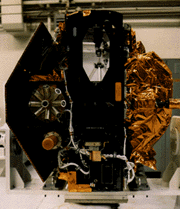
MSTI-2
Jump to: Mission Objectives, Mission Instrumentation, Mission Parameters, Additional Information
Mission Photos:

Courtesy of Air Force Research Laboratory
Mission Objectives:
The first satellite in the Miniature Sensor Technology Integration MSTI series, MSTI-1, was launched into low earth orbit (LEO) 21 November 1992 from Vandenberg Air Force Base, California, on a NASA SCOUT booster and succeeded in meeting all primary mission objectives. The spacecraft operated in its 400-km polar orbit until the spring of 1993. The MSTI-1 spacecraft weighed just 150 kg and was built for $19M in less than twelve months. The mission paved the way for the more sophisticated detection and tracking payload on MSTI-2.
The second MSTI satellite, MSTI-2, was launched into low earth orbit on 8 May 1994, aboard the last NASA SCOUT booster. The six month primary mission of the satellite was to demonstrate theater ballistic missile (TBM) tracking. The 170 kg MSTI-2 was injected into a 355 km x 455 km polar orbit and then executed an orbit raise to its final orbit, 432 km circular, sun-synchronous, 97.13-degree inclination. On May 8, MSTI-2 successfully acquired and tracked a Minuteman III launched from Vandenberg AFB.
Mission Instrumentation:
MSTI-2 has the following instrumentation onboard:
- Short wavelength infrared camera
- Medium wavelength infrared camera
- Retroreflector array
Mission Parameters:
| Sponsor: | US Air Force |
| Expected Life: | 6 months, mission complete |
| Primary Applications: | missile tracking |
| Primary SLR Applications: | experimental |
| COSPAR ID: | 9402801 |
| SIC Code: | 9009 |
| Satellite Catalog (NORAD) Number: | 23101 |
| Launch Date: | May 8, 1994 |
| RRA Diameter: | 18 cm |
| RRA Shape: | hemispherical |
| Reflectors: | 9 corner cubes |
| Orbit: | circular, sun-synchronous |
| Inclination: | 97.13 degrees |
| Eccentricity: | 0.000 |
| Perigee: | 432 km |
| Period: | 94 minutes |
| Weight: | 170 kg |




